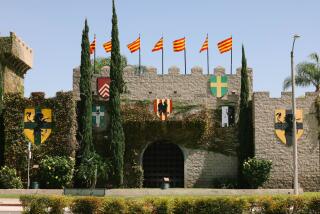MEDIEVAL TIMES: DINERS ARE HALF THE SHOW
- Share via
There are no plunging rides or whirling waterways at Medieval Times, the $7-million venture that opened June 5 near Disneyland and Knott’s Berry Farm.
Rather, the indoor dinner-arena show in Buena Park is a throwback to feudal days with its 11th-Century-styled tournament complete with horseback jousts and mock clashes with swords and axes.
But the knights and horses are only half the show.
Spectators, wearing little paper crowns and seated at tables above the arena floor, attack their meals in typical medieval manner--with bare hands. They bellow at their fawning serf-waiters. They cheer, stomp their feet and pound the tables with each slash and thrust of their chosen knights.
Even in today’s amusement market, with its King Kongs and its Spruce Gooses, Medieval Times stands out as something of a novelty, with its mix of equestrian derring-do and show-biz flash.
But entertainment for the masses is nothing new.
Twenty years ago, the first Medieval Times complex was opened on the Mediterranean island of Majorca by Spanish entrepreneurs. The indoor arena there is built on an estate still owned by descendants of an 11th-Century noble, the Count of Perelada, according to Medieval Times executive vice president Andres Gelabert.
The same partnership is involved in two other complexes in Spain, Gelabert said. The group runs a Medieval Times in Benidorm on the Alicante coast, and it has licensed the rights for another dinner-and-joust attraction in Barcelona.
The first foray into the United States came with the opening of a 1,100-seat arena the partnership built in Kissimmee, Fla., near Disney World, in December, 1983. That complex has listed 700,000 customers so far, said Gelabert, who also manages the two American complexes.
In Buena Park last year, Medieval Times took over a 6 1/2-acre property--complete with indoor amphitheater and stables--that had been vacated by Kingdom of the Dancing Stallions, an equestrian attraction that folded in 1983 after years of falling attendance.
Recruiting the equine talent for the new park has been relatively easy. The 28 horses, including Andalusian, Lippizaner and Arabian breeds, are all bought from Southern California ranches. The cost, Gelabert said, reaches as much as $10,000 per horse, although most are in the $2,000 range.
Recruitment of the human performers, however, can be a bit more difficult.
The recruits at the American complexes are a diverse lot that includes marketing students, artists, athletes, medieval history buffs and Medieval Times’ own waiters. Experience at the Spanish and Florida operations has shown that novice riders are easier to train for the rough-and-tumble action, Gelabert said.
Beside, explained Victor de Lara, a former cavalryman in the Spanish army and the chief knight at Buena Park, “even if we take an experienced rider, he has to be retrained. It is better to start from scratch. The main requirement is that they be very well-coordinated and fit.”
Also, not a softy.
The months-long training in tournament-riding and combat choreography is arduous and dangerous--fighting mounted on charging horses, wielding 10-pound swords and 15-pound maces, suffering injuries from mistimed stunts or crashes into barricades.
The most difficult stunt, though, may be attracting enough people to watch it all. When the Buena Park complex opened June 5, it did so amid dire projections fueled by attendance slumps at many Southern California attractions.
Even Medieval Times’ biggest neighbors, Disneyland in Anaheim and Knott’s Berry Farm in Buena Park, have reported that their box-office figures so far this year are well below the predictions of only a few months ago.
Another Buena Park neighbor, Movieland Wax Museum, was sold last year by the Six Flags conglomerate in the wake of a years-long attendance slide at the celebrity waxworks.
In addition, some operators in the field have questioned whether Medieval Times--saddled with what they see as an offbeat and relatively unchanging show format--can draw enough repeat business.
Such nay-saying does not appear to ruffle Gelabert. He insisted that the Buena Park Medieval Times is doing quite nicely for a newcomer in the Southern California market.
Although attendance at the 940-seat facility has dropped as low as 300 on weeknights, weekend performances usually sell out, he said. (Tickets are $23 for adults, $15.30 for children.)
As Gelabert put it, “There is no other show like ours. This was--and still is--our biggest selling point.”
It’s show time, and still half an hour before the first combat.
The crowd has been escorted through the Great Hall--with its coats of arms, royal decrees, bejeweled swords and Perelada banners--and past the gift shops displaying kid-size swords, axes, maces and helmets.
Now seated for their medieval-style eats, the spectators have become a vision of proper loutishness as they slurp soup, rip apart chickens, gnaw on spare ribs and egg on the contestants.
Below, the six fully costumed knights are going through their preliminaries: charging on horseback across the 120-foot-long sand-covered arena floor, hurling javelins at targets, thrusting lances through tiny rings.
Fear not; the customers know whom to cheer and jeer. The tiered seating is divided into six sections, each section’s colors corresponding to the hues worn by the knights.
By the time the jousts begin and the first “victims” are dumped, run through and carted off, the noise level from the stands is at rabble pitch.
The climactic duel between the Good Knight (Craig Romero) and the Intruder Knight (De Lara) is the evening’s niftiest. Intricately choreographed and vigorously performed, the duo’s slashing, parrying and tumbling never fail to raise deafening roars.
“People really get into the spirit of this. It’s fun, it’s harmless, and it’s historical,” said Jack Rein, the show’s master of ceremonies and chief rabble-rouser.
Still, by Medieval Times standards, this evening’s throng is relatively well-behaved, staying well within the house limits of boorishness.
This time, no one tried to jump into the arena (as some spectators have in the shows in Spain). This time, no one tossed meaty objects such as chicken legs or spare ribs into the arena (as some in Buena Park and Florida have done).
“Some people get carried away. Some nights, the noise can get pretty overwhelming, sometimes a little unnerving, especially for the newer knights,” said Romero, who joined Medieval Times three years ago in Florida.
“But you become used to it, even thrive on it. It’s all part of the show.”
More to Read
Inside the business of entertainment
The Wide Shot brings you news, analysis and insights on everything from streaming wars to production — and what it all means for the future.
You may occasionally receive promotional content from the Los Angeles Times.










